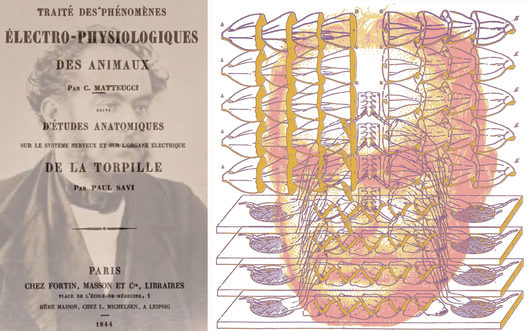Carlo Matteucci1811–1868
The action of nerves on muscles led first Matteucci and later du Bois-Reymond to propose the ways in which nerves propagate impulses. Experimental evidence of action potentials was to await technological advances in recording and amplifying small electrical signals; this was provided in 1928 by Lord Adrian (1889-1977) who was able to amplify the signals from a single isolated nerve fibre. When recordings of nerve impulses could be made from individual cells in the visual pathway their adequate stimuli could be determined. Adrian coined the term ‘receptive field’ to refer to this, and it was applied to other senses, too. Matteucci was born in Forli and studied in Bologna, Paris, Florence and Ravenna. He was appointed professor of physics at the University of Pisa in 1840. The scientific ideas that excited him most were those based on the studies of Galvani and Volta. Matteucci extended the experiments of Galvani on animal electricity and he provided the experimental basis for understanding how nerve impulses are propagated. The importance of Matteucci’s research was noted throughout Europe, and his papers were translated into several languages. An indication of the esteem in which he was held was the award of the Copley Medal by the Royal Society of London in 1844. He also wrote several books; the title page of his Traité is shown on the left, together with his portrait. This book has been described as the most important work on animal electricity after Galvani. Matteucci had been in correspondence with Michael Faraday (1791-1867) since 1833 and Matteucci’s first memoir to the Royal Society was communicated to it by Faraday. On the right, his portrait is combined with two of his diagrams showing the stacked nerve-muscle preparations (his galvanoscopic frogs) and the arrangements of frog’s legs on a board.
